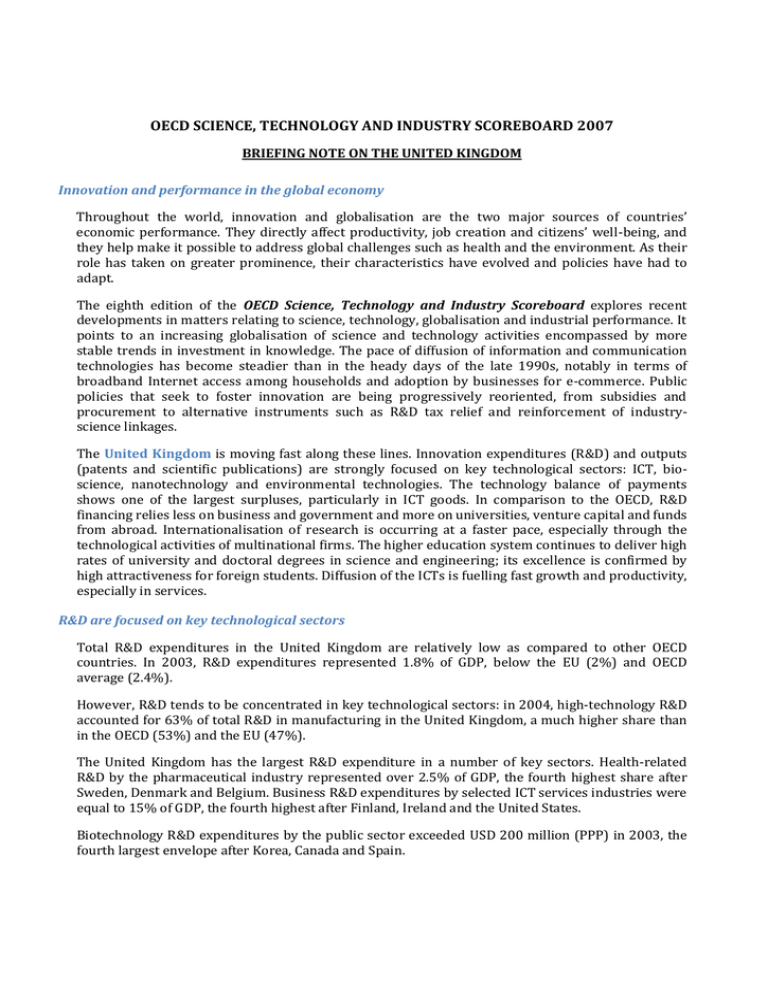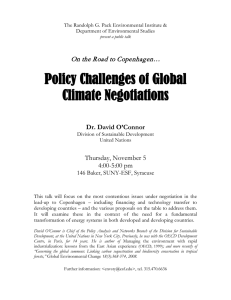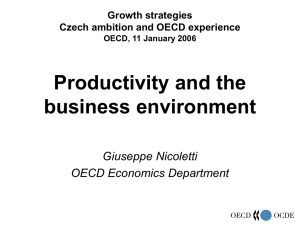OECD SCIENCE, TECHNOLOGY AND INDUSTRY SCOREBOARD 2007
advertisement

OECD SCIENCE, TECHNOLOGY AND INDUSTRY SCOREBOARD 2007 BRIEFING NOTE ON THE UNITED KINGDOM Innovation and performance in the global economy Throughout the world, innovation and globalisation are the two major sources of countries’ economic performance. They directly affect productivity, job creation and citizens’ well-being, and they help make it possible to address global challenges such as health and the environment. As their role has taken on greater prominence, their characteristics have evolved and policies have had to adapt. The eighth edition of the OECD Science, Technology and Industry Scoreboard explores recent developments in matters relating to science, technology, globalisation and industrial performance. It points to an increasing globalisation of science and technology activities encompassed by more stable trends in investment in knowledge. The pace of diffusion of information and communication technologies has become steadier than in the heady days of the late 1990s, notably in terms of broadband Internet access among households and adoption by businesses for e-commerce. Public policies that seek to foster innovation are being progressively reoriented, from subsidies and procurement to alternative instruments such as R&D tax relief and reinforcement of industryscience linkages. The United Kingdom is moving fast along these lines. Innovation expenditures (R&D) and outputs (patents and scientific publications) are strongly focused on key technological sectors: ICT, bioscience, nanotechnology and environmental technologies. The technology balance of payments shows one of the largest surpluses, particularly in ICT goods. In comparison to the OECD, R&D financing relies less on business and government and more on universities, venture capital and funds from abroad. Internationalisation of research is occurring at a faster pace, especially through the technological activities of multinational firms. The higher education system continues to deliver high rates of university and doctoral degrees in science and engineering; its excellence is confirmed by high attractiveness for foreign students. Diffusion of the ICTs is fuelling fast growth and productivity, especially in services. R&D are focused on key technological sectors Total R&D expenditures in the United Kingdom are relatively low as compared to other OECD countries. In 2003, R&D expenditures represented 1.8% of GDP, below the EU (2%) and OECD average (2.4%). However, R&D tends to be concentrated in key technological sectors: in 2004, high-technology R&D accounted for 63% of total R&D in manufacturing in the United Kingdom, a much higher share than in the OECD (53%) and the EU (47%). The United Kingdom has the largest R&D expenditure in a number of key sectors. Health-related R&D by the pharmaceutical industry represented over 2.5% of GDP, the fourth highest share after Sweden, Denmark and Belgium. Business R&D expenditures by selected ICT services industries were equal to 15% of GDP, the fourth highest after Finland, Ireland and the United States. Biotechnology R&D expenditures by the public sector exceeded USD 200 million (PPP) in 2003, the fourth largest envelope after Korea, Canada and Spain. OECD SCIENCE, TECHNOLOGY AND INDUSTRY SCOREBOARD 2007: BRIEFING NOTE ON THE UNITED KINGDOM Among OECD countries, the defence R&D budget in the United Kingdom was the second largest expenditure as a share of government-financed R&D (57% of the total in 2005) and the third largest as a share of GDP (0.2%). Universities and venture capital are key to R&D financing Compared to the EU and the OECD, R&D financing relies less on business and government and more on higher education, non-profit institutions and funds from “abroad”. Similarly, R&D activities are performed less by business and government and more by higher education and non-profit institutions. Venture capital is a major source of funding for new technology-based firms and a decisive determinant of entrepreneurship and innovation. In 2005, the United Kingdom attracted 11% of all OECD venture capital and over 40% of total EU venture capital investments. The share of venture capital investment in early-stage and expanding firms is among the highest in the United Kingdom (over 0.3% of GDP) and has been increasing at a fast rate over 2003-05 (35% a year). However, venture investment in the United Kingdom goes less frequently to high-technology sectors than in the OECD. Communications attracted more than 60% of high-technology investments in 2005. Government-financed R&D is biased in favour of large firms Together with France and the United States, the United Kingdom is the country in which the highest share of government-financed business R&D is directed at large firms. UK firms with under 250 employees received the smallest share of government-financed R&D in the OECD. The share of business R&D directed to small firms is slightly higher but it remains low compared to a majority of OECD countries. Government revenue forgone as a result of R&D tax credits can be substantial and amounted to about USD 1 billion in the United Kingdom in 2005. Collaboration with public research organisations (higher education or government research institutes) can be an important source of knowledge transfer for the innovation activities of firms. In 2004, the UK had one of the lowest shares of firms collaborating in innovation activities, irrespective of firm size. Patenting is high in bioscience, nanotechnology and ICT In 2005, the number of triadic patent families per million population in the UK (26) was below the EU25 (32) and the OECD average (44). Furthermore, this number decreased by 1% a year between 2000 and 2005. However, the United Kingdom is among the top performers for patents in a number of key technologies. Over the period 2002-2004, the share of national patents in high-technology sectors in the United Kingdom (46%) was higher than in the EU25 (38%) and the OECD (44%). In 2004, the United Kingdom was the fourth largest country for the number of bioscience, nanotechnology and ICT patents filed under PCT, after the United States, Japan and Germany. It was also among the top performers for environmental technology patents filed under PCT, notably solid 2 www.oecd.org/sti/scoreboard OECD SCIENCE, TECHNOLOGY AND INDUSTRY SCOREBOARD 2007: BRIEFING NOTE ON THE UNITED KINGDOM waste and renewable energy (ranked fourth), and motor vehicle abatement (ranked fifth after Germany, Japan, the United States and France). In 2005, the technology balance of payments showed the third largest surplus as a percentage of GDP, after Luxembourg and Sweden. Over 2002-04, the United Kingdom had the third highest rate of university patenting in the OECD, after Ireland and Spain. Overall, the higher education sector accounts for about 8% of all international patent applications. Over the same period, the UK was fifth in the share of patents filed under PCT owned by government; however, the proportion of patents owned by government agencies has decreased since the mid1990s. The United Kingdom is also characterised by significant regional concentration of PCT applications – it ranks sixth among OECD countries for geographic concentration. East Anglia is the second OECD region for the number of ICT and biotechnology patents per capita. The Berkshire, Bucks and Oxfordshire area is fifth for biotechnology patents. Investment in knowledge is driven by higher education Investment in knowledge (R&D, software and higher education) is the basis of innovation and technological progress. In 2003, investment in knowledge in the United Kingdom (3.5% of GDP) was below the EU13 (3.6%) and the OECD average (4.9%). Low investments in knowledge are mostly due to low R&D expenditure (1.8% of GDP, against 2% in the EU13 and 2.4% in the OECD) and low investment in higher education (0.7% of GDP, as compared to 0.8% in the EU13 and 1.4% in the OECD). Investments in software were in line with the OECD and over the EU13 average. Growth in investment in knowledge in the United Kingdom was among the lowest in OECD over 1997-2003, just above Ireland, Greece and Portugal. Increases in software expenditure were the major source of increased investment in knowledge. Although current investment in higher education is relatively low, the United Kingdom is the fourth OECD country in rates of doctoral degrees in science and engineering, and ranks sixth for the percentage of new degrees in the same disciplines. High international student mobility suggests that the quality of the education system is perceived as excellent. Non-citizen or international students represented over 40% of the doctoral population in the United Kingdom in 2004. In the same year, the UK was the second most attractive destination for foreign doctoral students in the OECD after the United States. In 2003, the United Kingdom ranked fifth in the OECD for relative prominence of cited scientific literature and sixth for the number of scientific articles per million population. Over the period 1999-2004, the UK had the third largest number of core and citing articles in environmental science (after the United States and Germany) and the fourth largest number in nanoscience (after the United States, Germany and Japan). The UK was sixth for the share of NPL (non-patent literature) citations over 1990-2004. 3 www.oecd.org/sti/scoreboard OECD SCIENCE, TECHNOLOGY AND INDUSTRY SCOREBOARD 2007: BRIEFING NOTE ON THE UNITED KINGDOM Attractiveness for S&T workers remains high The United Kingdom benefits from net inflows of professional and technical workers. In 2001, foreign workers accounted for about 12% of total professional and technical workers in the country. Positive net inflows mostly relied on the contribution of workers born in non-OECD countries. The UK, however, is also the third largest “exporter” of professional and technical migrants to the OECD area. Almost 10% of the professional and technical workers born in the United Kingdom are employed in another OECD country. Despite the good performance of the higher education system, skilled employment remains low as compared to other OECD countries. In 2006, the share of human resources in S&T was below the EU25 average while the share of tertiary-level graduates in total employment was just about the OECD average. Low unemployment rates of university graduates and a large earning differential in favour of tertiary-level employees suggests that the demand for skilled workers tends to outstrip supply. Diffusion of ICT is continuing… In 2003, ICT investments in the United Kingdom (as a percentage of gross fixed capital formation) were the fourth largest after the United States, Sweden and Finland. The share of software in total investment (11%) was among the five highest OECD countries in this respect. In the first half of the 2000s, the share of households with access to a computer at home increased by about 30 percentage points and access to home Internet was among the fastest growing in the OECD. 38% of adults use the Internet for online shopping. In 2006, the United Kingdom reported the second highest share of businesses selling and purchasing goods or services via the Internet and the second largest share of total enterprise turnover from ecommerce. The United Kingdom ranks second for the share of ICT-related occupations in the overall economy: in 2004, ICT specialists and basic and advanced users accounted for over 25% of total employment. In 2005, trade in ICT goods was above the OECD average and the ICT goods trade balance reported the fifth largest surplus. … and is fuelling growth and productivity ICT accounted for the bulk of capital contribution to GDP growth: about 0.3 to 0.7 percentage points of annual GDP growth in the United Kingdom was due to investment in ICT. Between 1995 and 2004 most OECD countries continued to experience a steady increase in the importance of knowledge-intensive services. Over the period 1995-2005, annual labour productivity growth in the United Kingdom was about 2% a year, over the OECD and the EU15 average. Business sector services accounted for the bulk of labour productivity growth: in the United Kingdom, the business sector accounted for over 55% of aggregate labour productivity growth. However, labour productivity growth in business sector services slowed over the period 2000-05. 4 www.oecd.org/sti/scoreboard OECD SCIENCE, TECHNOLOGY AND INDUSTRY SCOREBOARD 2007: BRIEFING NOTE ON THE UNITED KINGDOM In 2004, the United Kingdom ranked fourth, after Luxembourg, Switzerland and the United States, for the share of knowledge-intensive “market” services in the national economy: finance and insurance; post and telecommunications, and business services accounted for over 20% of the national GDP. High internationalisation of the economy… Foreign direct investment has progressed steadily in most countries since the mid-1990s. FDI outflows represented over 5% of GDP over 2000-05. In 2005, the United Kingdom occupied the first position among G7 countries for FDI inflows as a percentage of GDP, before the United Kingdom and France. As a result of significant FDI inflows, foreign-controlled affiliates account for a significant share of turnover and employment in the economy. In 2004, foreign-controlled affiliates accounted for over 40% of manufacturing turnover and just below 30% of manufacturing employment. The share of foreign affiliates in services represented about 30% of turnover and 15% of employment. … and even higher internationalisation of research The technological activities of multinational firms are increasingly internationalised. In the search for new technological competences, better adaptation to markets and lower research and development costs, companies are moving research activities overseas more intensively. Over 2001-03, around 40% of domestic inventions in the United Kingdom were owned by foreign residents, a substantial increase compared to 30% in the early 1990s. On average, R&D funding from abroad plays quite an important role in the funding of business R&D. Funds from abroad represented 15% of total business enterprise R&D funding in 2005, giving the UK the highest rank among OECD countries in this respect. As more multinationals set up offshore R&D laboratories, R&D activities in many OECD countries are becoming more internationalised and more closely linked to production abroad. In most countries, the share of foreign affiliates in total R&D is higher than their part in total manufacturing turnover, which suggests that research is now more internationalised than production. R&D performed abroad and by foreign affiliates represents on average well over 16% of total industrial R&D expenditure in the OECD area. In the UK, this share currently exceeds 35%. The share of foreign affiliates in R&D also reflects the size of their R&D effort relative to that of domestic firms. In 2004, the intensity of R&D (as a share of turnover) by foreign affiliates was notably higher than that recorded by domestic companies in the United Kingdom. International co-operation is a particular aspect of the globalisation of research activities. The world share of patents involving international co-invention increased from 4% in 1991-93 to 7% in 200103. In the United Kingdom, 23% of patent applications to the European Patent Office (EPO) in 200103 had at least one foreign co-inventor. International co-authorship has been growing as fast as domestic co-authorship. In 2005, 20.6% of scientific articles involved international co-authorship, a figure three times higher than in 1985. The United Kingdom had the third largest share of internationally co-authored scientific articles, after France and Germany. 5 www.oecd.org/sti/scoreboard








